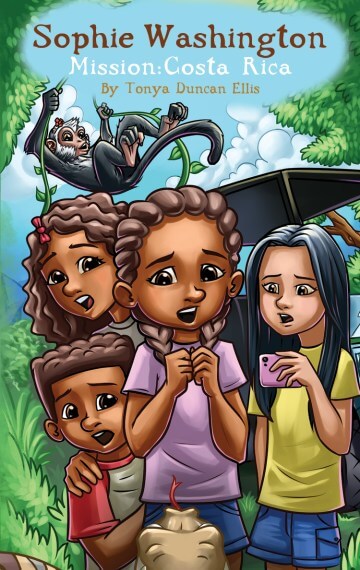At home wishing you were in Costa Rica? Even from afar, there are meaningful ways to connect with and learn about the country’s rich culture, abundant wildlife, and diverse ecosystems. In this two-part series, we’ll share 10 activities and resources that are fun for both kids and adults alike. Some are things we’ve enjoyed with our kids living here in Costa Rica. Others are books that the kids can explore on their own or for you to read together for an easy learning activity. We hope this virtual field trip gets you excited about your next Costa Rica trip, whenever that may be!
Be sure to also check out Part 2 of the series. This teaches you some amazing facts about sea-turtle nesting, fiery volcanoes, how bananas are grown, and even has cool museum tours you can do online.
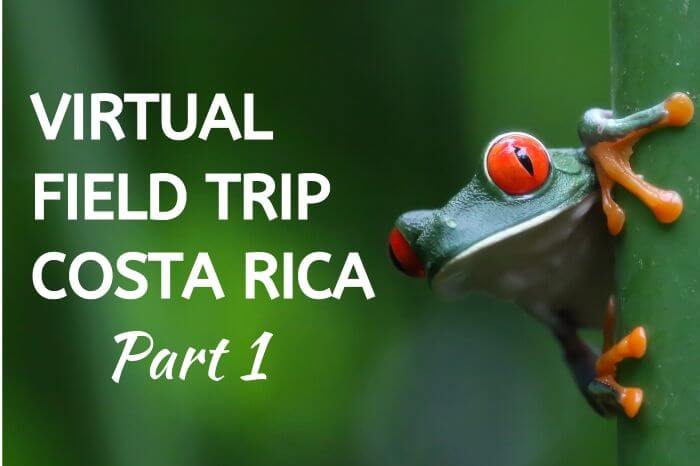
Cooking Beans from Scratch – A Costa Rican Tradition
Did you know that in Costa Rica almost everyone eats rice and beans at least once per day? It may sound crazy but it’s sort of like how you may eat a bowl of cereal or sandwich every day. You just get used to it!
Rice and beans are considered a traditional food in Costa Rica. In fact, beans are so important that in grocery stores here, you’ll find dozens of different types from many different companies. Some Costa Ricans prefer black beans, while others like red beans. In our house, we alternate.
Most of the beans we eat are grown right in Costa Rica. Once the beans mature, they are picked and dried (traditionally in the sun). Then they are put into bags and sent to stores. Unlike the beans you buy in a can, dried beans can’t be eaten right away. It takes some work to get them ready, but it’s worth it. You can infuse delicious flavors into the beans when you cook them yourself.
First, you need to sort the beans, then soak them for several hours, and finally you’ll have to cook them for a few hours more. This is a fun multiday activity to try with the family, but it’s really quite easy so a good one to do with the kids.
To bring this tradition into your own home, try our recipe. In that post, we also share a traditional Costa Rican dish with beans that most Ticos eat on a daily basis.
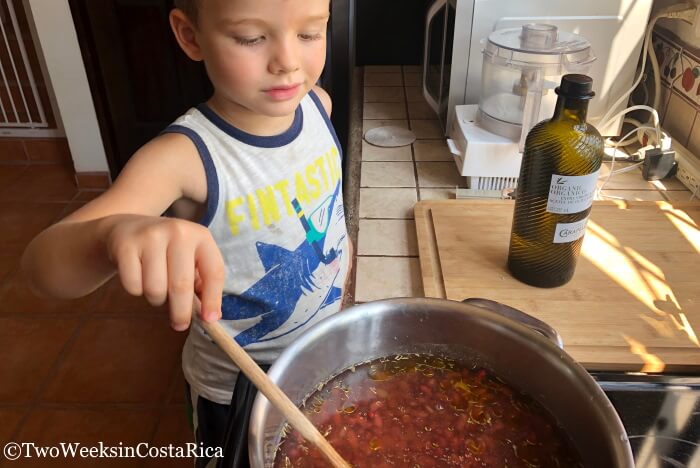
Learn About Pineapples and Plant One Too!
Background
Speaking of food, have you ever seen a pineapple from Costa Rica in the grocery store? There’s a good chance you have, even if you didn’t know it. That’s because pineapples are one of Costa Rica’s main fruit exports. In some areas of the country, there are giant pineapple fields so big, they seem to go on forever.
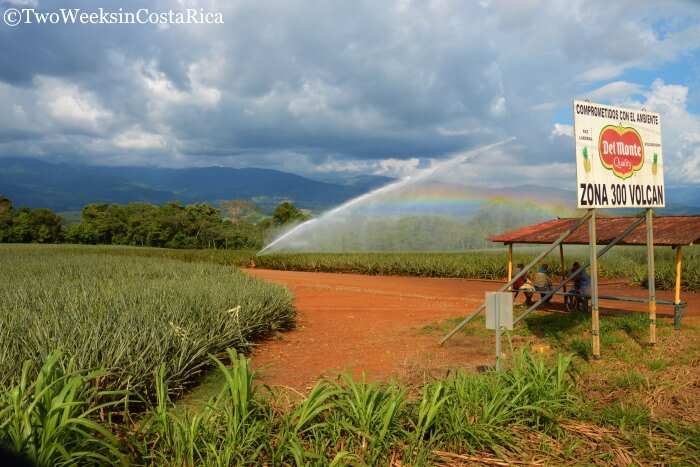
These farms produce a lot of fruit, but the pineapples aren’t anywhere as tasty as those grown on smaller farms. Smaller farms also have less of an impact on our environment since they don’t cut down as many trees or use as many chemicals. Costa Rica’s wildlife likes that!
To learn more about a smaller organic pineapple farm in Costa Rica, check out this link. Be sure to scroll down in the article to watch the video too. Near the end, farmer Andres shows a really cool way to cut a pineapple.
Plant a Pineapple
Even if you don’t live in climate that is warm year-round, you can still plant a pineapple in your house and watch it grow. All you need is a pineapple from the store, a pot of dirt, and your hands.
It can take 18-24 months, or even longer, for a pineapple plant to make a fruit. Depending on how much sun it gets, you may get a nice sized fruit or a small, ornamental pineapple flower. If you do this with kids, you could have them be responsible for the watering. We have some papaya and watermelon seeds growing at our house, and our four-year old is in charge of their daily maintenance.
4 Steps to Plant Your Own Pineapple
1) Twist off (don’t cut) the spiky green top of your pineapple. This will take a bit of strength, but all you do is hold the top base of the pineapple in one hand and green spiky part in the other. Then twist the top with some force until it breaks free. Note: Once you take the top off the pineapple, it will ripen quickly.
2) With the top off, remove about 4-5 rows of the lower (smallest) leaves (these are the ones you just exposed). This will show some little roots, which are usually brown dots, but they can sometimes be short and squiggly as well.
3) Press the pineapple top into soft, well-draining soil (roots first). Use your hands to firm the dirt around the roots.
Tip: If you are using a flowerpot, make sure it is at least 12” in diameter to give the pineapple enough space to grow. Here’s a link to a selection of choices you can buy online if you don’t have one at home.
4) Make sure your pineapple plant gets plenty of sun, and be sure to water it when the soil gets dry. For best results, keep the leaves dry and only water the soil.
If you want video instructions on how you plant a pineapple, we found a good link here.
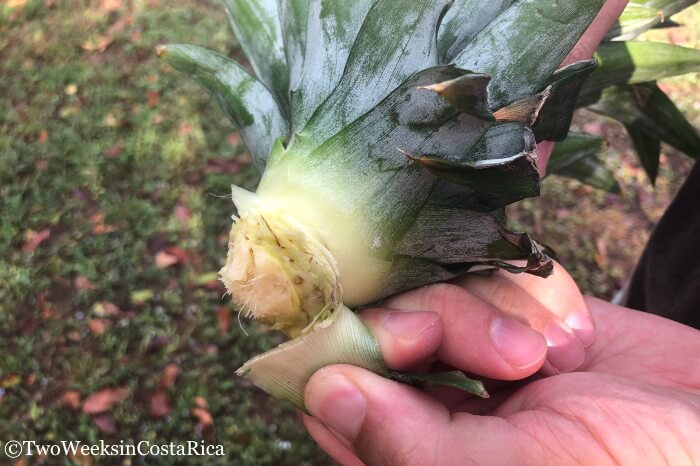
Wildlife Guides
Background
A big highlight of visiting Costa Rica is its amazing wildlife. In the tropical rainforest, you can find monkeys, sloths, crocodiles, toucans, and all kinds of other jungle animals.
Before your trip, it’s both fun and important to learn about some of these creatures. Field guides are one of the best ways to learn. Using the write ups and pictures in these guides, you can find out where different animals live, what they eat, and other cool facts about them.
For example, did you know that the call of a howler monkey can be heard from up to three miles (4.8 km) away? That’s far! Just knowing this fact will help you figure out on a hike what made that crazy noise you heard, how close you are, and if you might be within distance to see it. The more you learn, the better chances you will have to spot some of your favorite animals in the wild. Additionally, if you already know the basic facts about Costa Rica’s wildlife, your tour guides are more likely to share some of their in-depth knowledge with you since they can skip the simple stuff.
Which Field Guides Are Best?
The best simple field guide that we have found is The Wildlife of Costa Rica by Fiona Reid, Twan Leenders, and Jim Zook. This book has a lot of information but the descriptions are shorter and not over-the-top “sciency.” It also has some great colorful pictures and illustrations. Our four-year-old son often grabs this book when we find a strange insect in our house or want to know more about an animal we saw.

For some very simple fold out field guides, you can look at Rainforest Publications. They have several different ones, including mammals, marine animals, reptiles, birds, butterflies, and amphibians. So one day, you can learn about what you’d see snorkeling along the coral reef at Costa Rica’s Cano Island, and another day, about the country’s 42 species of tree frog (see cover photo, above). These pocket guides don’t have much information besides the names of animals, birds, plants, etc. But they have colorful illustrations and are laminated so smaller kids can’t rip them and they carry along well in a day pack.
Wildlife Camera Traps and Videos
Background
To see some of Costa Rica’s wildlife in action before you visit yourself (and test out what you learned with your field guides), check out some cool camera trap videos online. Camera traps are small cameras that are hidden in the jungle. They are attached to trees or other structures and have sensors so that when a creature moves past them, it takes their picture or a video.
We set up some of these in our own jungle backyard in Costa Rica a few years back and saw some fun surprises. You can read more about how we did it and what we saw here.
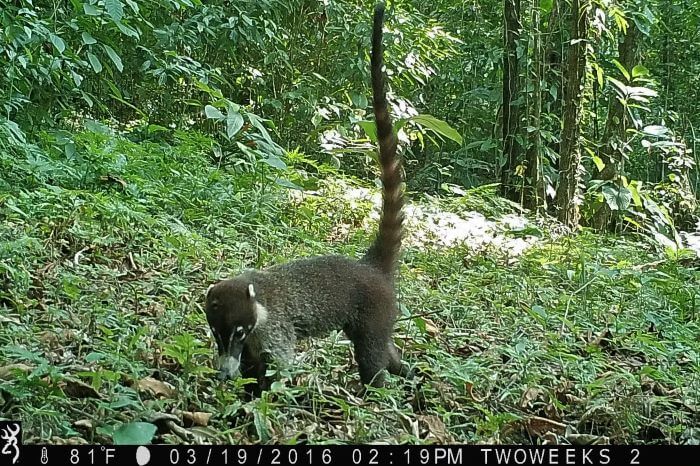
Other Camera Traps to Check Out
To see even more animals, there are other Costa Rica camera traps you can check out. Here are a few of our favorites.
Hacienda Baru (southern Pacific coast near Dominical) – Hacienda Baru is a hotel and wildlife reserve that has been regrowing and protecting a section of land formerly used for cattle ranching. After working at it for more than 30 years, the wildlife has come back and now there are more animals than ever.
To see some of the species on Hacienda Baru’s property, check out their Facebook videos. You’ll be able to catch a glimpse at monkeys, big cats like pumas and ocelots, armadillos, and anteaters. Something interesting you may also notice are strange tunnels. These were put in under the new coastal highway to help protect the wildlife. They make it so the animals don’t have to cross the busy road above and risk getting hit.
Ocho Verde (southern Pacific coast near Golfito) – These guys have a fun YouTube channel with lots of trail camera footage as well as other videos that guide you through different animal experiences. You can see and learn about things like jungle cats, snakes, and interesting bugs.
Guanacaste Wildlife Monitoring (northern region of Costa Rica) – Guanacaste has mostly what scientists call tropical dry forests. That means the forests are adapted to long stretches without rain. Many trees even lose their leaves during drought. While you wouldn’t think there would be as much wildlife there, as compared to say, the rainforest, these camera traps prove otherwise.
Check out their YouTube channel to see things like pumas, coyote, coati (raccoon-like animals), agouti, and many interesting birds.
Costa Rica Storybooks
To finish part one of our virtual field trip, we thought we’d leave you with some Costa Rica-themed storybooks. For the kids, there are plenty of fun ones, plus we’ll plug our own book for adults looking for a Costa Rica-themed story to take them out of their everyday life.
Where’s the Sloth? (Ages 3 to adult) – This look-and-find book will remind you of Where’s Waldo but with cute little sloths to find instead!
National Geographic Little Kids First Big Book of the Rain Forest (Readers 4-8) – This book, while not specifically about Costa Rica’s rainforests, teaches kids some amazing facts. It also shows them where rainforests are located around the globe. There are over 200 colorful photographs of things like frogs, snakes, monkeys, and plants. We have some of the other books in this series for our son, and he loves them! They have awesome illustrations and lots of detail to teach them some science.
Lovely Amelia Travels (Costa Rica) (Readers 4-12) – Lovely Amelia Travels is a series about a little girl who visits exciting destinations around the world. In this one, she goes to Costa Rica and explores jungle, volcanoes, and more. Written by a native Costa Rican woman who traveled the globe as a nanny.
If I Ran the Rain Forest: All About Tropical Rain Forests (Readers 4-9) – Everyone loves Cat in the Hat books and this one is no different. Here, the Cat takes Sally and Dick through the different layers of the rainforest, meeting animals and people and learning about plants along the way.
Sophie Washington: Mission Costa Rica (Readers 8-12) – Part of a nine-book series, this one takes a sixth grader and her friends to Costa Rica for service work. It didn’t go as expected and the friends have lots of adventures.
Two Weeks in Costa Rica (written mostly for adults) – This was our first book that we wrote several years ago and is where the name for our website came from. It’s a fun little travelogue that sweeps Jenn and Matt (that’s us!) away from the snowy weather in Boston to Costa Rica’s tropical beaches and rainforests. Of course, like any trip, there were some bumps along the way.
Conclusion
We hope this list of resources and activities gives you some ideas on how to connect with Costa Rica, even from your home. Be sure to check out Part 2 in our virtual field trip series for more awesome ways to discover the country’s food, culture, and wildlife.
Did you try one of the activities? How did it go?Leave us a comment below.
Some of the links in this post are connected to affiliate programs we have joined. As an Amazon Associate we earn from qualifying purchases.
Planning your Costa Rica dream trip? Check out these posts:
Family Travel: Why Costa Rica is the Perfect Destination – Want to explore a new culture with your kids? This post explains why Costa Rica is a comfortable travel destination for families.
Best Time to Visit Costa Rica – If you are considering which month to plan your visit, this post will lay out your options. Things covered include weather conditions and busiest/least crowded months.
Best Beaches for Families in Costa Rica – Looking for a calm cove and shady palm tree? Costa Rica has many surfing beaches with rougher water, but this post will guide you to destinations that are safe for your little swimmers.


